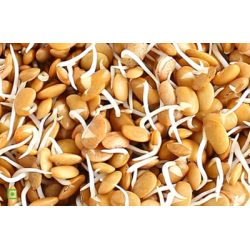Model: Sweet Corn/ American Corn
Sweet Corn:Benefits: High in vitamins B6 and C, and provides dietary fiber and antioxidants; supports digestion and provides energy.Uses: Enjoyed fresh, grilled, or boiled; used in salads, soups, salsas, and as a side dish; can also be added to casseroles and baked goods.Storage: Store fresh corn in..
₹25 ₹35
Ex Tax:₹25
Model: Mixed Sprouts
Mixed Sprouts: (Mix of Brown Channa, Moong, Lobia, Horse Gram)Benefits: Packed with vitamins (like C and K), minerals (such as iron and calcium), and antioxidants; rich in dietary fiber and protein; supports digestion, immune function, and overall health.Uses: Ideal for salads, sandwiches, wraps, an..
₹29 ₹40
Ex Tax:₹29
Model: Moong Sprouts
Moong Sprouts:Benefits: High in protein, vitamins (particularly B vitamins), and minerals (such as iron and magnesium); rich in antioxidants and dietary fiber; supports digestion, immune function, and overall health.Uses: Great in salads, sandwiches, wraps, and as a garnish; can be added to soups, s..
₹29 ₹40
Ex Tax:₹29
Model: Horse Gram Sprouts/ Kulthi
Horse Gram Sprouts:Benefits: Rich in protein, fiber, vitamins (especially B vitamins), and minerals (like iron, calcium, and magnesium); supports digestion, boosts energy, and contributes to overall health.Uses: Commonly used in salads, soups, and curries; can be added to stir-fries or used as a hea..
₹29 ₹40
Ex Tax:₹29
Model: Channa Sprouts
Brown Channa Sprouts:Benefits: High in protein, dietary fiber, and essential minerals like iron and magnesium; supports digestion, heart health, and overall energy levels.Uses: Great for salads, soups, stews, and as a topping for various dishes; can also be added to curries or enjoyed as a healthy s..
₹29 ₹40
Ex Tax:₹29
Model: Baby Corn
Baby Corn:Benefits: Low in calories and high in vitamins A and C; provides dietary fiber and antioxidants; supports digestion and overall health.Uses: Commonly used in stir-fries, salads, soups, and as a garnish; can be steamed, grilled, or sautéed.Storage: Store in the fridge for up to 1 week in a ..
₹39 ₹50
Ex Tax:₹39
Model: Peeled Sambar Onion
Peeled Sambar Onion:Benefits: Provides vitamins and minerals such as vitamins C and B6, manganese, and folate; contains antioxidants that support overall health and may aid digestion.Uses: Essential in South Indian dishes like sambar, curries, and stews; adds a mild, sweet flavour to recipes and can..
₹60 ₹80
Ex Tax:₹60
Model: Grated Coconut
Grated Coconut:Benefits: Rich in healthy fats, fiber, vitamins (like C and B vitamins), and minerals (such as manganese and potassium); supports heart health, digestion, and energy levels.Uses: Commonly used in baking, curries, desserts, and as a topping for various dishes; also adds texture and fla..
₹75 ₹80
Ex Tax:₹75











